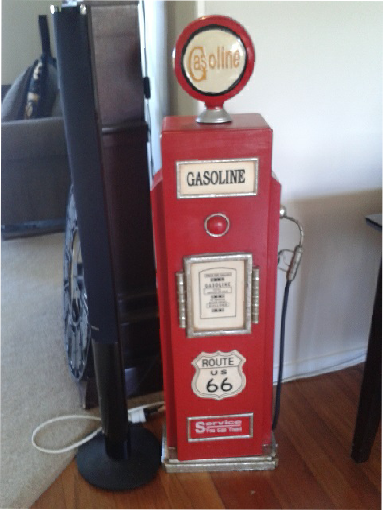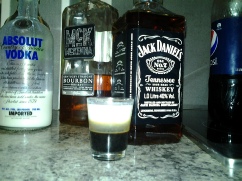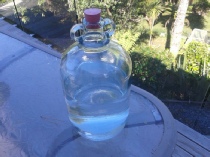
My Booze Cabinet
E

How to make spirits with your still
Overview
In short, there are four main processes involved in making your own spirits and/or liqueurs
1. Making and Fermenting a "Wash"
2. Operating the Still
3. Diluting & Filtering 4. Flavouring
Equipment needed:-
Fermenter, Alcolmeter, temperature gauge, Carbon Filtering Unit, Mixing Spoon, Bottles
Consumables needed:-
Steriliser, Castor Sugar 7kg, Turbo Spirit Yeast, Clearing Agent, Turbo Carbon (Optional), flavours
1) Making & Fermenting the Wash
Sterilisation
Clean and sterilise all your fermenting equipment including fermenter, airlock, tap, hydrometer and spoon.
Mixing the wash
Follow instructions on packet or
- Fill your fermenter 6 litres of very warm water. Mix in sugar /dextrose then add more water to get to 21 litres and correct temperature
- It is optional to add Turbo Carbon. U dont bother and it still tastes nice. (It does give it a different flavour)
Fermentation
Fix the lid on fermenter, fit the airlock in the lid and half fill it with water.
Fermentation will be apparent within a few hours
Completion
Fermentation is complete when the yeast has consumed all of the dextrose. App. 7 days at 20-24°C (Cooler is OK, but takes longer)
Once complete de-gas using stirrer for app 1-2 mins, (paint mixer on drill is easy also)
Drain into still
2) Operating the Still
Use still instructions
Water flow
Monitor the temperature of the condenser as the still heats up, you will know when its time to turn on water as steam comes out of still and it should be drips.
You want to adjust the flow of water so that you maintain a temperature of between 78 - 80°C (best temperature for quality distillate)
What you really want is a quick drip, not a steady flow
Collecting Distillate
Collect the first 100 mls of distillate and discard. This is the Head. It is non-drinkable and must be discarded (It is also good as a cleaning agent)
The rest of the distillate contains the Ethanol (alcohol)
The alcometer is the tool to measure the strength of the distillate. Fill the test jar with the distillate and drop the alcometer in. The alcometer will float and the alcohol % will be the mark showing exactly on the surface of the liquid.
When measuring the strength of your spirit, remember your alcometer is calibrated for liquid at around 20°C.
Refer to the Temperature Correction Chart Below to make the relevant adjustments.
I dont bother and just add same amount of water as what was distilled (EG 3litres water to 3 litres of alcohol)
e.g. If your Spirit Hydrometer reads 50%V at a temperature of 25o Celsius, then you should read the Correction Adjustment from the chart and subtract 1.88 to give a realistic reading of 48.12% V (50.00 - 1.88)
I dont bother and just add the same amount of water as spirits (EG 3 litres of spirit / 3 litres of water)
Between 40% and 45% for best taste. (although up to you)
.Always use standard tap water to dilute … filtered or distilled water can create cloudiness and affect taste
Carbon Filter Process.
Follow the instructions provided when purhasing
I use the Essencia Carbon filter and found cartridges to expensive, so i have cut the paper top out and replace the carbon myself after 5 washes. Save a lot of money.
Flavouring
Instructions are on each mix you buy
- Funnily enough i love the mixes that make 5 litres of spitrit
All You need to do is a bit of searching and you can make all your own spirits and liqueurs
|
|
0.3 |
0.4 |
0.5 |
0.6 |
0.7 |
0.8 |
0.9 |
0.95 |
|
10°C |
4.12 |
3.98 |
3.67 |
3.42 |
3.19 |
2.92 |
2.45 |
2.06 |
|
15°C |
2.03 |
2 |
1.85 |
1.73 |
1.61 |
1.47 |
1.25 |
1.06 |
|
20°C |
0 |
0 |
0 |
0 |
0 |
0 |
0 |
0 |
|
25°C |
-2.01 |
-1.95 |
-1.88 |
-1.76 |
-1.65 |
-1.51 |
-1.31 |
-1.12 |
|
30°C |
-4.06 |
-3.94 |
-3.78 |
-3.55 |
-3.33 |
-3.05 |
-2.67 |
-2.31 |
|
35°C |
-6.15 |
-5.98 |
-5.82 |
-5.4 |
-5.13 |
-4.67 |
-4.07 |
-3.54 |
|
40°C |
-8 29 |
-8 05 |
-7 92 |
-7 41 |
-7 03 |
-6 35 |
-5 5 |
-4 8 |




Some hard earned tips
- I have tried Carbon in the wash and find althogh carbon gives a smoother taste, i prefer to not use it and i leave the wash for about two weeks and it clears a bit and then i distill
- After distilling i put the vodka into a flagon bottle as this means minnimal washing (Means i only steralise 1 flagon and bottles as i need them)
- I also make 5 litres of bourbon at a time into a flagon bottle
- Use a heat pad in winter
- If you distill in the kitchen like i do, start before your women gets up, then plead stupidity
- Always use standard tap water to dilute after putting through still - filtered or distilled water can create cloudiness and affect taste


Vodka
Wine
